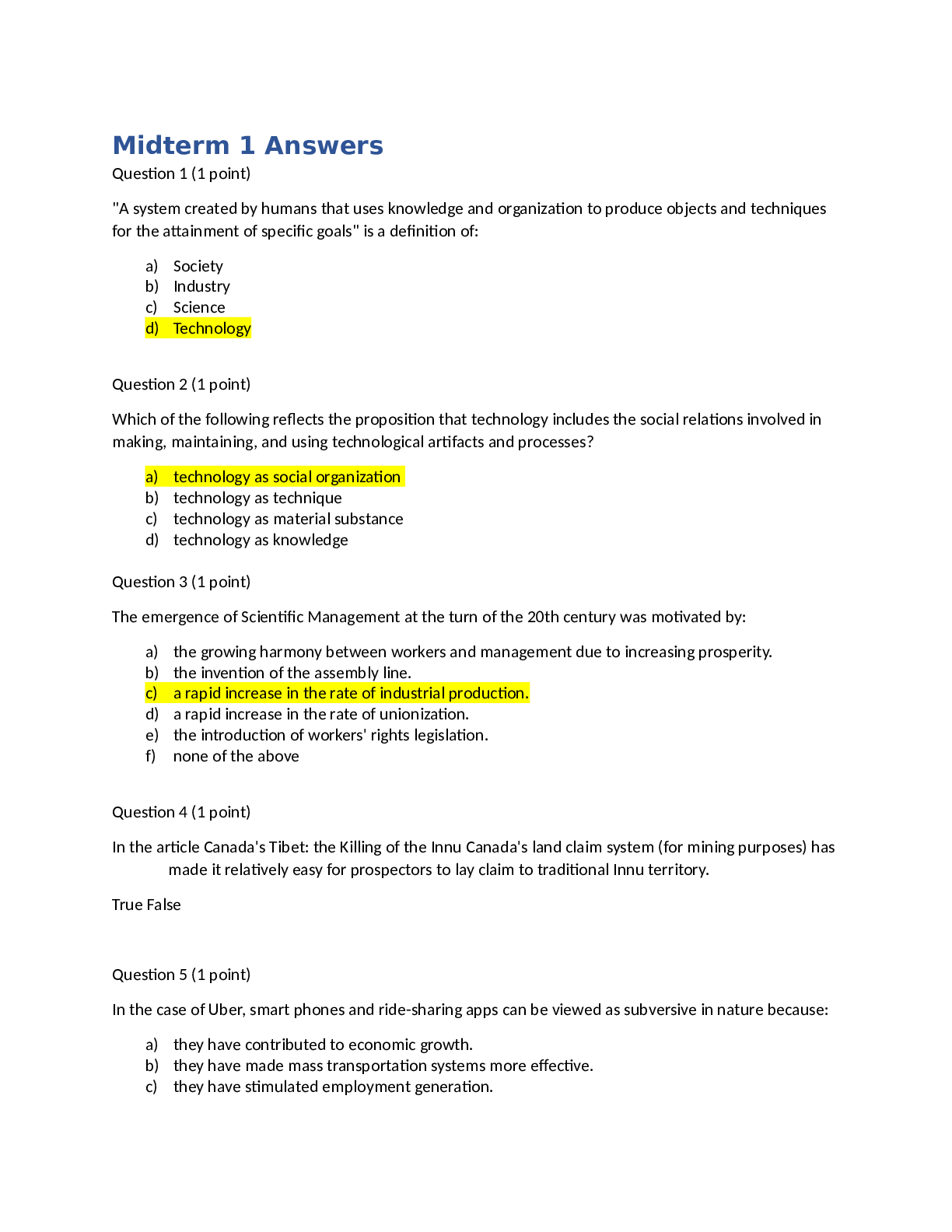Lippincott’s Anesthesia Review: 1000 Questions and Answers
Document Content and Description Below
Contributors Preface 1. Perioperative Evaluation and Management PREET SINGH, MANISH PUROHIT, ASHISH SINHA, AND PAUL SIKKA 2. Airway Management YURIY BRONSHTEYN AND EDWARD BITTNER 3. Anesthesia M... achine PAUL SIKKA 4. Patient Monitoring DARREN HYATT, ALA NOZARI, AND EDWARD BITTNER 5. Fluid Management and Blood Transfusion REBECCA KALMAN AND EDWARD BITTNER 6. Anesthetic Pharmacology MIAN AHMAD AND ASHISH SINHA 7. Spinal and Epidural Anesthesia THOMAS HALASZYNSKI 8. Peripheral Nerve Blocks THOMAS HALASZYNSKI9. Pain Management THOMAS HALASZYNSKI 10. Orthopedic Anesthesia THOMAS HALASZYNSKI 11. Cardiovascular Anesthesia DEPPU USHAKUMARI AND ASHISH SINHA 12. Thoracic Anesthesia DEPPU USHAKUMARI AND ASHISH SINHA 13. Neuroanesthesia DIPTY MANGLA AND ASHISH SINHA 14. Gastrointestinal, Liver, and Renal Diseases THOHA PHAM 15. Endocrine Diseases JEAN KWO AND EDWARD BITTNER 16. Ophthalmic, Ear, Nose, and Throat Surgery THOHA PHAM 17. Obstetric Anesthesia THOHA PHAM 18. Pediatric Anesthesia DIPTY MANGLA AND ASHISH SINHA 19. Critical Care DAVID STAHL, DANIEL JOHNSON, AND EDWARD BITTNER20. Postoperative Anesthesia Care SHERI BERG AND EDWARD BITTNER 21. Miscellaneous Topics PAUL SIKKA AND THOMAS HALASZYNSKIPerioperative Evaluation and Management Preet Singh, Manish Purohit, Ashish Sinha, and Paul Sikka 1. Preoperative application of scopolamine patch to prevent postoperative nausea and vomiting should be avoided in A. Female, 35 years old B. Smoker, 20 years old C. Patient with a blood pressure of 160/96 mm Hg D. Male, 70 years old 2. Which of the following drugs is least likely to be effective for prophylaxis for postoperative nausea and vomiting? A. Ondansetron B. Scopolamine patch C. Aprepitant D. Metoclopramide 3. Famotidine, when used for stress ulcer prophylaxis, must be avoided preoperatively in which of the following patients? A. Patients with replaced mitral valve on warfarin B. Patients with idiopathic thrombocytopenic purpura (ITP) for splenectomy C. Patients with achalasia cardia for esophageal myotomy D. Patients with a history of coronary stenting on aspirin4. Which of the following drugs antagonizes substance P in the central nervous system and is used as premedication to prevent postoperative nausea and vomiting? A. Palonosetron B. Aprepitant C. Metoclopramide D. Prochlorperazine 5. Which of the following predictors is likely to be associated with lower incidence of perioperative nausea and vomiting? A. Female gender B. Use of fentanyl for pain relief C. Patients with a history of smoking D. Patients undergoing laparoscopic surgery 6. All of the following have an antiemetic action, except A. Promethazine B. Propofol C. Etomidate D. Haloperidol 7. Cefazolin, as a component of perioperative antimicrobial prophylaxis for surgery, must begin within what time before incision? A. Simultaneously with incision B. Within 30 minutes prior to incision C. Within 60 minutes prior to incision D. Within 120 minutes prior to incision 8. Vancomycin, as a component of perioperative antimicrobial prophylaxis for surgery, must begin within what time before incision? A. Simultaneously with incision B. Within 30 minutes prior to incision C. Within 60 minutes prior to incision D. Within 120 minutes prior to incision9. A 65-year-old male with a history of hypertension and diabetes presents to emergency department with altered sensation with a likely subdural hematoma. To assess his cardiorespiratory status, he is asked about his level of physical activity. If he is capable of performing at least which of the following activities independently, he is less likely to have significant cardiopulmonary ailment during surgery? A. Walk to washroom on level floor B. Play the accordion C. Walk one block D. Climb a flight of stairs 10. In preoperative assessment of patients, physical activity is graded in terms of metabolic equivalents (METs). The value that corresponds to oxygen consumption of 1 MET in an adult is A. 2 mL/kg/min B. 7 mL/kg/min C. 3.5 mL/kg/min D. 5.5 mL/kg/min 11. As per American Society of Regional Anesthesia (ASRA) guidelines, intravenous infusion of unfractionated heparin should be stopped how long prior to a planned epidural? A. 1 to 1.5 hours B. 2 to 4 hours C. at least 12 hours D. at least 24 hours 12. For emergent surgery, anticoagulation produced by warfarin can be reversed by using A. Fresh-frozen plasma (FFP) B. Injectable vitamin K C. Prothrombin complex concentrate D. Factor VIII concentrate 13. Neuraxial block is not contraindicated for patients on which of the following drugs?A. Warfarin B. Low-molecular-weight heparin C. Aspirin D. Clopidogrel 14. All of the following are risk factors for obstructive sleep apnea, except A. Obesity B. Short neck C. Enlarged tonsils D. Female gender 15. A 70-year-old male, who is diabetic for the last 20 years, is scheduled for an elective surgery. Which of the following is not a sign of autonomic diabetic neuropathy? A. History of recurrent diarrhea B. History of postural hypotension C. History of recurrent constipation D. History of urinary retention 16. Which of the following perioperative factors in patients undergoing dialysis prior to surgery predicts the possibility of hypotension (due to increased volume removed)? A. Change in serum sodium B. Change in body weight C. Change in serum potassium D. Change in pH after dialysis 17. A patient with a history of severe asthma is scheduled for an appendectomy. Which of the following induction agents will cause the least respiratory depression? A. Ketamine B. Propofol C. Etomidate D. Thiopental18. Which of the following drugs can significantly prolong the QT interval on the ECG? A. Dexamethasone B. Droperidol C. Aprepitant D. Glycopyrrolate 19. Which of the following tests is used to confirm coagulation after stopping low-molecular-weight heparin (LMWH)? A. PT B. aPTT C. ACT D. None of the above 20. Effect of combined administration of midazolam and fentanyl is A. Additive B. Synergistic C. Competitively antagonistic D. Noncompetitively antagonistic 21. Preoperative anesthetic evaluation is likely to bring down the incidence of all the following, except A. Case cancellations B. Patient morbidity C. Preoperative anxiety D. Direct procedural costs 22. For elective procedures, an anesthesia provider must obtain informed and preferably written consent A. Just prior to transferring the patient to the operating room for surgery B. During preoperative anesthetic evaluation C. At the same time that a surgeon obtains consent for the surgical procedure D. Just prior to induction of anesthesia in the operating room23. An optimal preoperative evaluation is designed A. To screen for and properly manage comorbid conditions B. To assess the risk of anesthesia and surgery and lower it C. To identify patients who may require special anesthetic techniques or postoperative care D. All the above 24. ASA classification for risk stratification is validated for predicting preoperative morbidity associated with the following, except A. General or regional anesthesia B. Conscious sedation C. Monitored anesthesia care D. Surgical procedure 25. A healthy pregnant patient in labor has which of the following ASA classifications? A. I B. II C. III D. IV 26. Sedatives, as premedication, must be avoided in which of the following patients? A. Uncontrolled hypertensive B. Toddler for tonsillectomy C. Brain tumor patients D. Patients with alcohol abuse 27. As per the American Society of Regional Anesthesia (ASRA) guidelines, which of the following drugs can be continued preoperatively in patients planned for neuraxial blockade for an elective procedure? A. Aspirin B. Clopidogrel C. Warfarin D. Low-molecular-weight heparin28. As per ASA classification, a controlled hypertensive patient with no target end-organ damage scheduled for elective surgery will be classified as A. ASA I B. ASA II C. ASA III D. ASA VI 29. A brain-dead organ donor undergoing laparotomy for “kidney harvesting” will be classified as an A. ASA III B. ASA IV C. ASA V D. ASA VI 30. A moribund patient who is not expected to survive without the operation is categorized as an A. ASA III B. ASA IV C. ASA V D. ASA VI 31. A patient with a history of uncontrolled hypertension, diabetes, and angina, who is to undergo a laparoscopic cholecystectomy, will be classified as an A. ASA II B. ASA III C. ASA IV D. ASA V 32. A 65-year-old male with a history of mitral valve replacement 2 years back presents for a knee replacement. He is on warfarin since the time of valve replacement. As per ASRA guidelines, the ideal time to stop his warfarin prior to surgery would be A. 12 hours B. 3 days C. 5 daysD. 10 days 33. A 26-year-old female, with a history of rheumatic mitral stenosis, is scheduled for an elective cesarean section at 38 weeks of gestation. Just prior to surgery, she is diagnosed to have atrial fibrillation (AF) with no hemodynamic instability. The first step in preparation for surgery is A. Perform an echocardiogram to rule out left-atrial clot B. Synchronized DC cardioversion under sedation C. Antiarrhythmic medication D. Plan for therapy postdelivery 34. A 72-year-old patient with a history of hypertension and angina at moderate activity is to undergo a laparoscopic cholecystectomy. Due to decreased effort tolerance and a significant blockade of left anterior descending coronary artery onstress thallium, a preprocedure coronary intervention is planned. Which of the following procedures performed prior to the elective surgery is least likely to delay the laparoscopic surgery? A. Coronary artery bypass graft (CABG) B. Percutaneous coronary stenting—bare-metallic stent C. Percutaneous coronary stenting—drug-eluting stent D. Percutaneous balloon dilatation 35. Which of the following is not seen as a result of primary renal disease in patients with chronic renal failure? A. Hypocoagulable state B. Hypercoagulable state C. Hyperproteinemia D. Anemia 36. A 2-year-old child is to undergo a tonsillectomy. The child had formula milk 2 hours ago. As per ASA guidelines, optimal NPO status would be to wait another _____ before proceeding to surgery: A. No waiting, since it is a child B. 2 hours C. 4 hours D. 6 hours [Show More]
Last updated: 1 year ago
Preview 1 out of 583 pages
Instant download
.png)
Buy this document to get the full access instantly
Instant Download Access after purchase
Add to cartInstant download
Reviews( 0 )
Document information
Connected school, study & course
About the document
Uploaded On
Jul 11, 2021
Number of pages
583
Written in
Additional information
This document has been written for:
Uploaded
Jul 11, 2021
Downloads
0
Views
186


.png)



.png)



 David L.png)
.png)

